Antennae Band7 - Calibration for CASA 3.3
Overview
This section of the AntennaeBand7 CASA Guide will cover the calibration of the raw visibility data. To skip to the imaging portion of the guide, see: Antennae Band7 - Imaging. If you have not already downloaded the raw data, you may do that now by clicking on the region closest to your location and downloading the file named 'Antennae_Band7_UnCalibratedMSandTablesForReduction.tgz':
North America Europe East Asia
Once the download has finished, unpack the file in a terminal outside CASA using 'tar -xvzf Antennae_Band7_UnCalibratedMSandTablesForReduction.tgz' and change directory (cd) to the directory Antennae_Band7_UnCalibratedMSandTablesForReduction. Then start CASA with the 'casapy' command.
The data have already been converted to CASA Measurement Set (MS) format using the CASA task importasdm. Accompanying the data are some basic calibration tables you will need for the following reduction, specifically, the Tsys and WVR calibration tables.
Initial Inspection
We will eventually concatenate the ten datasets used here into two large datasets corresponding to the northern mosaic (NGC 4038) and the southern mosaic (NGC 4039). However, we will keep them separate for now until imaging. We start by defining an array "basename_all" that includes the names of the ten measurement sets. This will simplify the following steps by allowing us to loop through the files using a simple 'for' loop in python. Remember that if you log out of CASA, you will have to re-issue the array "basename_all".
# In CASA
basename_all=["uid___A002_X1ff7b0_Xb","uid___A002_X207fe4_X3a","uid___A002_X207fe4_X3b9",
"uid___A002_X2181fb_X49","uid___A002_X1ff7b0_X1c8","uid___A002_X207fe4_X1f7",
"uid___A002_X207fe4_X4d7","uid___A002_X215db8_X18","uid___A002_X215db8_X1d5",
"uid___A002_X215db8_X392"]
The first step is to get some basic information about the data. We do this using the task listobs, which will output a detailed summary of each dataset.
# In CASA
for asdm in basename_all:
listobs(vis=asdm+'.ms')
Note that after cutting and pasting a 'for' loop you often have to press return twice to execute. The output will be sent to the CASA logger. You will have to scroll up to see the individual output for each of the datasets.
Here is an example of the (abridged) output from listobs for the first dataset in the list, uid___A002_X1ff7b0_Xb.ms (northern mosaic).
============================================================================= MeasurementSet Name:/Users/despada/Desktop/Imaging/Antennae/Datasets/band7/uid___A002_X1ff7b0_Xb.ms ============================================================================= Observer: Unknown Project: T.B.D. Observation: ALMA(11 antennas) Data records: 181357 Total integration time = 4931.71 seconds Observed from 28-May-2011/01:25:27.6 to 28-May-2011/02:47:39.3 (UTC) Fields: 26 ID Code Name RA Decl Epoch SrcId 0 none 3c279 12:56:11.1666 -05.47.21.5247 J2000 0 1 none Titan 12:42:43.9481 -01.43.38.3190 J2000 1 2 none NGC4038 - A* 12:01:53.1701 -18.52.37.9200 J2000 2 3 none NGC4038 - A* 12:01:51.9030 -18.51.49.9437 J2000 2 4 none NGC4038 - A* 12:01:52.4309 -18.51.49.9437 J2000 2 5 none NGC4038 - A* 12:01:52.9587 -18.51.49.9437 J2000 2 6 none NGC4038 - A* 12:01:53.4866 -18.51.49.9436 J2000 2 7 none NGC4038 - A* 12:01:54.0144 -18.51.49.9436 J2000 2 8 none NGC4038 - A* 12:01:52.1669 -18.51.56.4319 J2000 2 9 none NGC4038 - A* 12:01:52.6948 -18.51.56.4318 J2000 2 10 none NGC4038 - A* 12:01:53.2226 -18.51.56.4318 J2000 2 11 none NGC4038 - A* 12:01:53.7505 -18.51.56.4318 J2000 2 12 none NGC4038 - A* 12:01:51.9030 -18.52.02.9201 J2000 2 13 none NGC4038 - A* 12:01:52.4309 -18.52.02.9200 J2000 2 14 none NGC4038 - A* 12:01:52.9587 -18.52.02.9200 J2000 2 15 none NGC4038 - A* 12:01:53.4866 -18.52.02.9200 J2000 2 16 none NGC4038 - A* 12:01:54.0144 -18.52.02.9199 J2000 2 17 none NGC4038 - A* 12:01:52.1669 -18.52.09.4082 J2000 2 18 none NGC4038 - A* 12:01:52.6948 -18.52.09.4082 J2000 2 19 none NGC4038 - A* 12:01:53.2226 -18.52.09.4082 J2000 2 20 none NGC4038 - A* 12:01:53.7505 -18.52.09.4081 J2000 2 21 none NGC4038 - A* 12:01:51.9030 -18.52.15.8964 J2000 2 22 none NGC4038 - A* 12:01:52.4309 -18.52.15.8964 J2000 2 23 none NGC4038 - A* 12:01:52.9587 -18.52.15.8963 J2000 2 24 none NGC4038 - A* 12:01:53.4866 -18.52.15.8963 J2000 2 25 none NGC4038 - A* 12:01:54.0144 -18.52.15.8963 J2000 2 (nVis = Total number of time/baseline visibilities per field) Spectral Windows: (9 unique spectral windows and 2 unique polarization setups) SpwID #Chans Frame Ch1(MHz) ChanWid(kHz)TotBW(kHz) Ref(MHz) Corrs 0 4 TOPO 184550 1500000 7500000 183300 I 1 3840 TOPO 344845.586 488.28125 1875000 344908.33 XX YY 2 1 TOPO 343908.086 1875000 1875000 344908.33 XX YY 3 3840 TOPO 356845.586 488.28125 1875000 344908.33 XX YY 4 1 TOPO 343908.086 1875000 1875000 344908.33 XX YY 5 128 TOPO 344900.518 15625 2000000 344908.33 XX YY 6 1 TOPO 343892.705 1796875 1796875 344908.33 XX YY 7 128 TOPO 356900.518 15625 2000000 344908.33 XX YY 8 1 TOPO 343892.705 1796875 1796875 344908.33 XX YY Antennas: 11 'name'='station' ID= 0-3: 'DV02'='A015', 'DV04'='J505', 'DV06'='T704', 'DV07'='A004', ID= 4-7: 'DV08'='A072', 'DV09'='A008', 'DV10'='A009', 'DV11'='A016', ID= 8-10: 'PM01'='T702', 'PM02'='A017', 'PM03'='J504' ================================================================================
This output shows that three sources were observed: 3c279, Titan, and NGC4038 (Antennae northern galaxy). Source id 0 (3c279) will serve as the gain calibrator and bandpass calibrator; source id 1 (Titan) will serve as the flux calibrator; and source id 2 (NGC 4038) is, of course, the science target. Note that the source id 2 is composed of a number of field ids, each corresponding to a different pointing in the mosaic. In particular, a total of 23 pointings can be found in the northern mosaic (NGC 4038), and 29 pointings in the southern mosaic (NGC 4039).
Note that in the data there are more than two spectral windows IDs even though the observations were set up to have two spectral windows. The first one, with spectral id equal to 1, is centered on the CO(3-2) emission line in the Antennae, in the Lower Side Band (LSB). There is also one additional spectral window, with spectral id 3, in the Upper Side Band (USB). The spectral resolution and total bandwidth of these two spectral windows are 488.28 MHz and 1.875 GHz (3840 channels, FDM mode), respectively, corresponding to 0.426 km/s and 1634 km/s. In the original datasets there are also two spectral windows (spectral ids 5 and 7) fully covering spectral windows 1 and 3, but in TDM mode (2 GHz bandwidth, 128 channels) instead of FDM, which are used to derive the Tsys calibration tables. We provided in Antennae_Band7_UnCalibratedMSandTablesForReduction.tar.gz the Tsys calibration tables to apply (asdm+'.tsys.cal.fdm'), so there is no need to use these spectral windows anymore. Also, we find spectral windows 2, 4, 6 and 8, which contains channel averages of spectral windows 1, 3, 5 and 7, respectively, but these are not useful for the offline data reduction. Spectral window 0 contains the WVR data, but these are provided in the form of a calibration table (asdm+'.wvr.cal') in Antennae_Band7_UnCalibratedMSandTablesForReduction.tar.gz as well.
The final column of the listobs output in the logger (not shown above) gives the scan intent. This information is used later to flag the pointing scans and the hot and ambient load calibration scans, using scan intent as a selection option. Also these intents will be used in the future for pipeline processing.
A total of 11 antennas were used for the dataset listed above. Note that numbering in python always begins with "0", so the antennas have IDs 0-10. To see what the antenna configuration looked like at the time of this observation, we will use the task plotants (Figure 1).
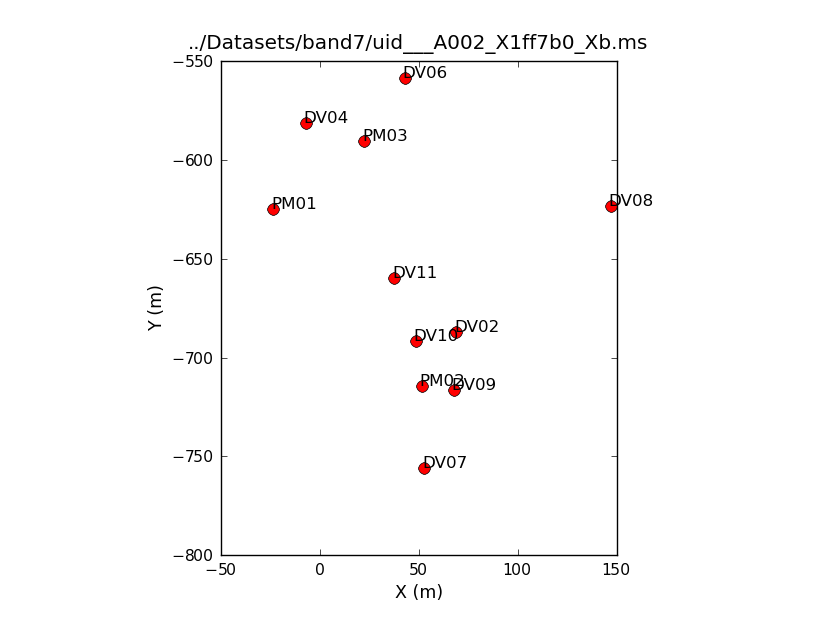
# In CASA
asdm=basename_all[0]
plotants(vis=asdm+'.ms', figfile=asdm+'.plotants.png')
This will plot the antenna configuration on your screen as well as save it under the specified filename (asdm+'.plotants.png') for future reference. You can check using plotants for the other datasets that the configuration stays relatively constant during the course of the observations. This corresponds to a configuration similar to extended configuration in ALMA cycle 0.
Data edition
General flagging
The first editing we will do is some a priori flagging with flagdata to flag shadowed data, and flagautocorr to flag the autocorrelation data contained in ALMA data, as we are only interested in the cross-correlation data. Remember that you first need to redefine the "basename_all" array if you logged out of CASA prior to starting this subsection.
# In CASA
basename_all=["uid___A002_X1ff7b0_Xb","uid___A002_X207fe4_X3a","uid___A002_X207fe4_X3b9",
"uid___A002_X2181fb_X49","uid___A002_X1ff7b0_X1c8","uid___A002_X207fe4_X1f7",
"uid___A002_X207fe4_X4d7","uid___A002_X215db8_X18","uid___A002_X215db8_X1d5",
"uid___A002_X215db8_X392"]
Now we will loop over the datasets, running the two flagging commands:
# In CASA
for asdm in basename_all:
flagdata(vis=asdm+'.ms',mode = 'shadow', diameter=12.0, flagbackup = F,)
flagautocorr(vis=asdm+'.ms')
In the flagdata task we choose:
- vis = asdm+'.ms' : each measurement set
- mode='shadow',diameter=12.0: flag shadowed data, taking into account that antennas are 12m diameter
- flagbackup = F: Do not automatically backup any flag file, as we will save it together with other flag instances using flagmanager after we finish all the initial flagging in this subsection
There are a number of scans in the data that were used for pointing and atmospheric (i.e. Tsys) calibration, and are no longer needed. We can flag them using flagdata by selecting them on the 'intent' keyword:
# In CASA
for asdm in basename_all:
flagdata(vis=asdm+'.ms', mode='manualflag', intent='*POINTING*',flagbackup = F)
flagdata(vis=name+'.ms', mode='manualflag', intent='*ATMOSPHERE*',flagbackup = F)
This time mode='manualflag', in order to flag only selected data.
Finally we store the current flagging information using flagmanager for each dataset:
# In CASA
for asdm in basename_all:
flagmanager(vis = asdm+'.ms', mode = 'save', versionname = 'Apriori')
Note that it is also possible to set flagdata to flagbackup=T so that it stores automatically the flags at each of the flagging steps without the need of flagmanager.
Apply Tsys and WVR calibration tables
Tsys (system temperature) and WVR (Water Vapor Radiometer) calibration tables were included in the Antennae_Band7_UnCalibratedMSandTablesForReduction directory, in the form asdm+'.tsys.cal.fdm' and asdm+'wvr.cal', respectively. These tables have been provided to you because they are not currently generated inside CASA. This situation will change in data taken in Early Science.
Tsys calibration tables
ALMA does not automatically scale the data by system temperature (Tsys) as would be done at other radio telescopes. Tsys measurements correct for the atmospheric opacity (to first-order), both in the time and frequency domains, and put weights to the visibilities in the subsequent imaging. The FDM (3840 channels per baseband, over 1.875 GHz) mode Tsys calibration tables were obtained using those of the TDM mode spectral windows (2 GHz, 128 channels per baseband), which we interpolated to obtain Tsys information for all the FDM channels.
We inspect the Tsys tables for the spectral window spw=1 with the task plotcal. We want to check that Tsys data have reasonable values. Estimated Tsys under average atmospheric observations for a given band can be found for example in the sensitivity calculator.
We plot the Tsys for all the antennas and polarizations (XX and YY) as a function of frequency for the first dataset.
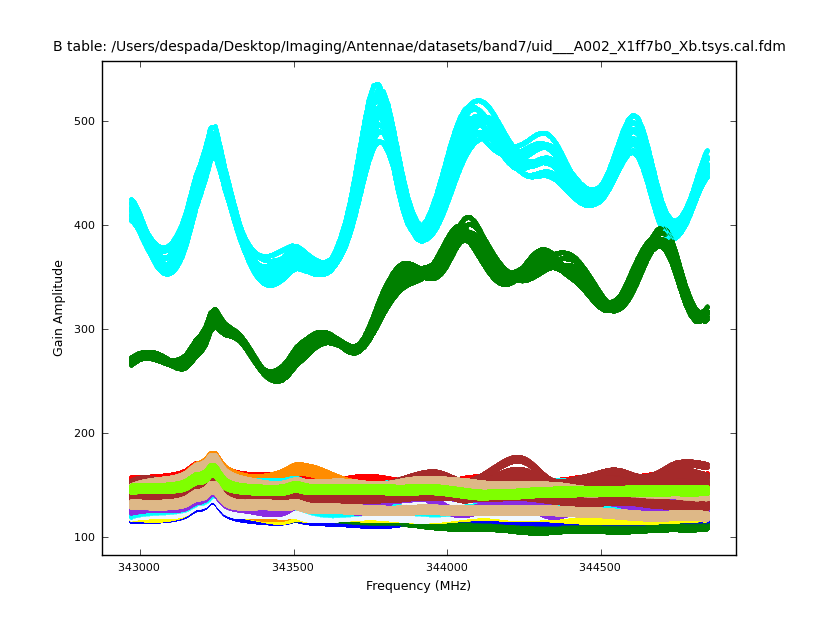
#In CASA
asdm=basename_all[0]
plotcal(caltable=asdm+'.tsys.cal.fdm',
xaxis="freq",yaxis="amp",
timerange='<1e8',spw='1',
plotsymbol=".")
Here spw='1' means the spectral window where CO(3-2) is. A large value for the time range (timerange='<1e8') is chosen to force averaging within each scan in the dataset. Not averaging all scans allow us to see any large deviation as a function of time as well.
In Figure 2, the Tsys solutions look reliable, with typical values ~150 K, except for some large values of Tsys at ~300 and 400 K (green and blue lines). By plotting each antenna individually, one finds that this corresponds to the two polarizations of DV04. Therefore, the data for that antenna will need to be flagged. There is also a mesospheric absorption line at about 345.2 GHz that makes Tsys larger, as seen in all of the other antennas. By applying the Tsys calibration tables in the data we will minimize the contribution of these absorption lines.
You can inspect the rest of datasets, and the
Apply Tsys and WVR tables
We apply next the Tsys and the WVR calibration tables to the data with the task applycal. We loop through all the datasets and sources to apply the Tsys and WVR calibration tables.
# In CASA
for asdm in basename_all:
for fieldname in ['Titan','3c279','NGC4038*','Antenna*']:
applycal(vis=asdm+".ms", spw='1',
field=fieldname, gainfield=fieldname,
interp='nearest',
gaintable=[asdm+".tsys.cal.fdm",asdm+'.wvr.cal'])
where:
- field: the field to which we will apply the calibration,
- gainfield: the field from which we wish to take the calibration table
- spw='1' : select only spectral window 1
- interp='nearest': use the interpolation mode to the 'nearest' solution.
Now you can use plotms to show some of the before-and-after effects of applying the calibration. Just run plotms to plot the amplitude versus channel in order to check if atmospheric absorption lines have been effectively corrected.
# In CASA
asdm=basename[0]
plotms(vis=asdm+'.ms',
field='3c279',
xaxis='channel', yaxis='amp',
selectdata=T, spw='1', correlation='XX',
avgtime='1e8',avgscan=T,
coloraxis='baseline' )
We have chosen field='3c279', correlation='XX', and averaged over time (avgtime='1e8', avgscan=T). We plot the different baselines with a different color. If the window is still open, check 'force reload'. This will display the uncorrected phases across the band. To display the corrected phases, you will need to select 'corrected' in the 'Data Column' field of the 'Axes' tab in plotms and re-plot. The amplitude as a function of channel should look flatter with the corrected data. You can also check that the amplitude of the corrected data as a function of time (xaxis='time') is flatter as well, as we have removed part of the atmospheric contribution on the amplitude using the Tsys calibration (for example, due to different elevation of the source with time).
We also recommend to plot plotms with keywords xaxis='channel', yaxis='amp' (this time with avgchannel=3840 instead of avgtime='1e8',avgscan=T) to check the effect of the WVR corrections. We expect smaller phase scatter in the corrected data, as the effect of atmospheric fluctuations on phase (time scales of ~1 sec) is calibrated with the help of WVR.
Additional individual flagging
Next we do some additional inspection using plotms in order to flag data. We will do this in the time (continuum plot) and spectral domains.
Continuum plot
First we will plot amplitude versus time (see Figure 3), averaging over all channels of spectral window 1 (spw = 1, where the CO(3-2) line is) and colorizing by field, for example for the first dataset. Scans on Titan are colored red, the bandpass and phase calibrator 3c279 is colored black, and the different pointings of the Antennae mosaic in different colors. Figure 4 shows the phase versus time plot, with the same color.
Check carefully that the amplitudes and phases vary smoothly with time. The Tsys corrected data should have approximately constant amplitudes and the WVR corrected data should usually have lower phase scatter. Note that the amplitudes in Figure 3 are decreasing, as a result of the decreasing elevation of the source. The Tsys corrected data (choose 'corrected' in Axes > Data Column in plotms) show constant amplitudes.
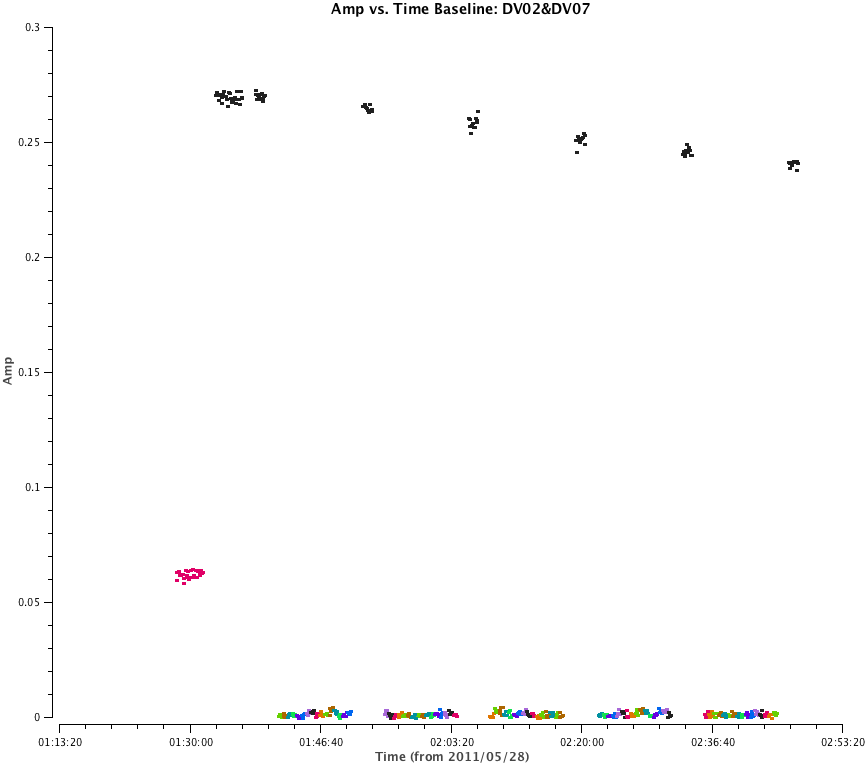
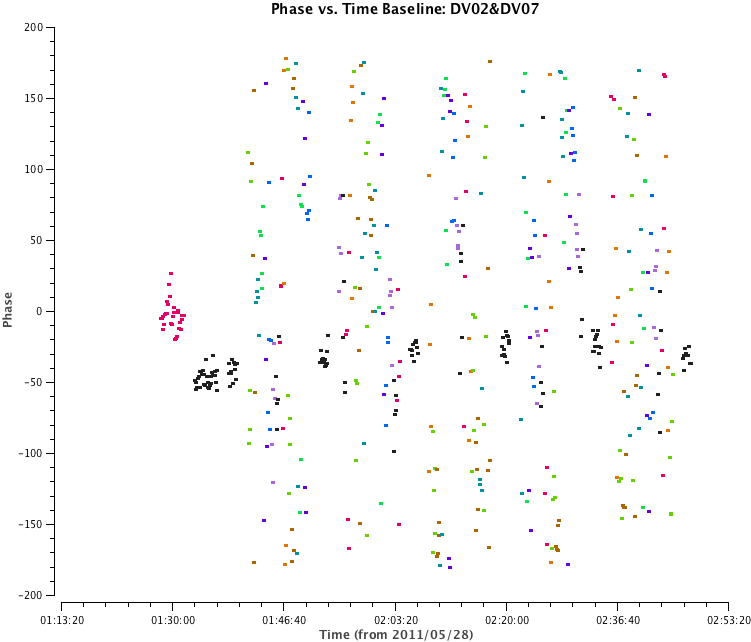
These are the plotms instances to produce the continuum plots, amplitude and phase versus time:
# In CASA
asdm=basename_all[0]
plotms(vis=asdm+'.ms',
xaxis='time', yaxis='amp',
selectdata=True, spw='1', correlation='XX',antenna='*&*',
avgchannel='3840', avgscan=T,
iteraxis='baseline',coloraxis='field')
plotms(vis=asdm+'.ms',
xaxis='time', yaxis='phase',
selectdata=True, spw='1', correlation='XX',antenna='*&*',
avgchannel='3840', avgscan=T,
iteraxis='baseline',coloraxis='field')
where:
- xaxis='time', yaxis='X' : a plot of X (amplitude or phase) versus time.
- avgchannel='3840' : average over all the channels in the spectral window.
- spw='1', correlation='XX',antenna='*&*': Select only the spectral window 1, polarization XX and cross-correlation data.
- iteraxis='baseline',coloraxis='field': Iterate over baseline, and colorize by different fields.
Select correlation='YY' to inspect the other polarization.
Especially important is to look that there are no sudden phase jumps or decrease in amplitude, larger scatter in phase for the gain calibrator (probably as a result of decorrelation due to weather conditions, which will be more relevant for the longest baselines), and that enough phase calibrator visibilities are available to calibrate the source data. In case you find any of these problems, you may want to flag the data.
Spectral plot
Second we plot the amplitude and phase versus frequency for the two correlations, XX and YY. Figure 5 and 6 show an example of spectral plot for the bandpass and phase calibrator 3c279, for both correlations. Again, since this source is a quasar, the amplitudes should be constant (Tsys corrected) and phases varying smoothly with frequency.
These are the task instances to obtain these plots:
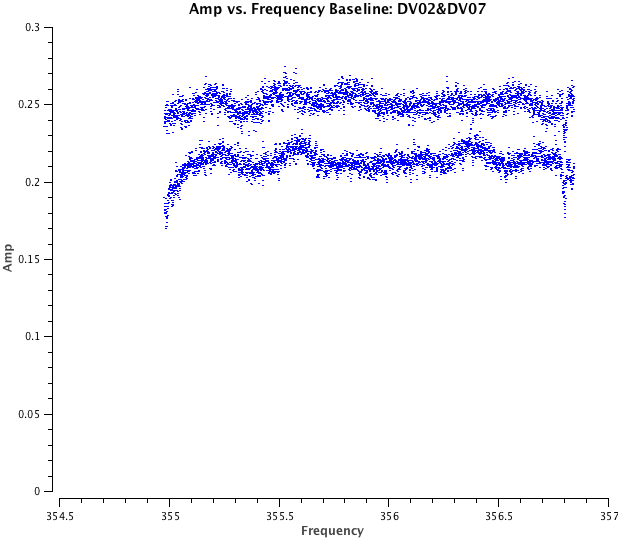
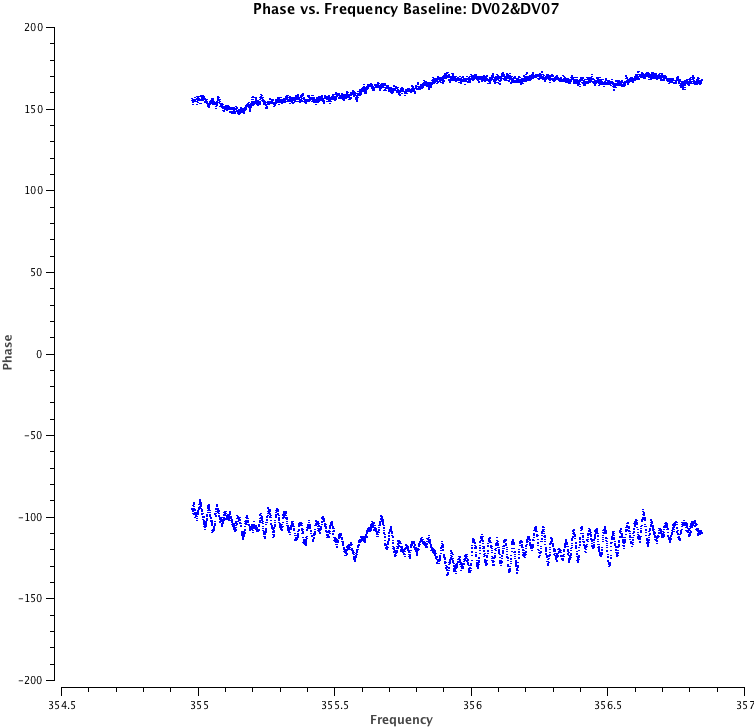
# In CASA
plotms(vis = asdm+'.split.ms',
xaxis = 'frequency',yaxis = 'phase',
field='3c279'
avgtime = '1e8',avgscan = T,
selectdata=True, antenna = '*&*',
iteraxis='baseline')
plotms(vis = asdm+'.split.ms',
xaxis = 'frequency',yaxis = 'amp',
field='3c279'
avgtime = '1e8',avgscan = T,
selectdata=True, antenna = '*&*',
iteraxis='baseline')
where:
- xaxis = 'frequency',yaxis = 'X': plot X (amplitude or phase) versus frequency
- field = '3c279': plot only our bandpass and phase calibrator
- avgtime = '1e8',avgscan = T: average all scans and integrations
- antenna = '*&*: plot only cross-correlation data
- iteraxis='baseline': iterate for each baseline
There are no large phase delays found in any of the datasets (i.e., usually less than one wrap over the bandpass), so bandpass calibration should remove this effect properly.
Using these plots we look for channels that would need to be flagged, for example, in the edges of the band, or as a result of spurious interferences.
You can plot other sources as well. By selecting any pointing of Antennae, you should be able to see clearly the (still uncalibrated) CO(3-2) line. The flux calibrator also present some emission line in this spectral window, that will need to be flagged (check the flux calibration subsection).
Individual Flagging
First we use flagdata to remove the edge channels from both sides of the bandpass:
# In CASA
flagdata(flagbackup = F,vis = asdm+'.split.ms',spw = '1:0~7,1:3831~3839')
Continue to inspect the data with plotms, plotting different axes and colorizing by the different parameters. Don't forget to average the data if possible to speed the plotting process. The time ranges to insert in flagdata can be obtained using plotms Tools Hover/Display. Instead of using the following flagdata commands, you can also flag by hand in plotms. To do this, select your bad data by clicking on the 'Mark Regions" button, then on 'Flag".
File:AntennaeDataInspection-Band7.txt contains the different problems that have been identified for all the datasets. We indicated how to flag the bad data in different instances of the flagdata command. For example, for the first dataset we find that DV04 Tsys is too large in comparison with the other antennas. Also, in the continuum phase plot of all baselines * & PM03, we find that corr=YY for the spw=3 need to be flagged. In the spectral amplitude plot, it is possible to discern some spurious interferences in a few channels. Finally we flag the data with mode='manualflag' and selecting the data to flag. Finally, we save the flag version using flagmanager.
asdm="uid___A002_X1ff7b0_Xb"
flagdata(vis = asdm+'.ms',mode='manualflag',flagbackup = F,antenna='DV04')
flagdata(vis = asdm+'.ms',mode='manualflag',flagbackup = F,
antenna='PM03',correlation='YY',spw='3')
flagdata(vis=asdm+'.ms', flagbackup=F, antenna=['DV12','PM03'],
spw=['0:639~640;1663~1664;2431~2432','1:1146~1147;2182~2184'])
flagmanager(vis =asdm+'.ms',mode = 'save',versionname = 'FlagFinal')
Other minor problems that are reported for this dataset are: 1) in the spectrum phase plot: DV02 10 degrees peak to peak noise in one of the correlations and 2) in the continuum phase plot: *&DV09, there is a sudden change of ~ 200 deg. at 2:03:20, but these can be calibrated.
Split the Tsys/WVR calibrated data
We split out the CORRECTED_DATA column with the task split. This will get rid of the extraneous spectral windows, including the channel averaged spectral windows and spw 0, which is the one that contained the WVR data. We give the resulting datasets the extension ".split.ms". Since split will not overwrite existing files, we start by removing any previous versions of the measurement sets created in this step before running the split command again.
# In CASA
for asdm in basename_all:
os.system('rm -rf '+asdm+'.split.ms')
split(vis=directory+asdm+'.ms', outputvis=asdm+'.split.ms',
datacolumn='corrected', spw='1')
The WVR and Tsys tables are now applied in the DATA column of the new measurement sets (i.e. asdm+'.split.ms'). That will contain only one spectral window, spectral window 0 (the previous spectral window 1), containing the window where the CO(3-2) line information is.
Bandpass and gain calibration
Next we plot the phase as a function of time and frequency for the bandpass calibrator, 3c279. For the first plot, Figure 7, we use avgscan=T and avgtime='1e8' to average in time over all scans and integrations, and we specify coloraxis='baseline' to colorize by baseline. For the second, Figure 8, we use spw='0:40~3800' and avgchannel='3840' to average over the central channels of the first spectral window. For both plots we will iterate on antenna (interaxis='antenna'). Use the green arrows of the plotms GUI to view the plots for different antennas.
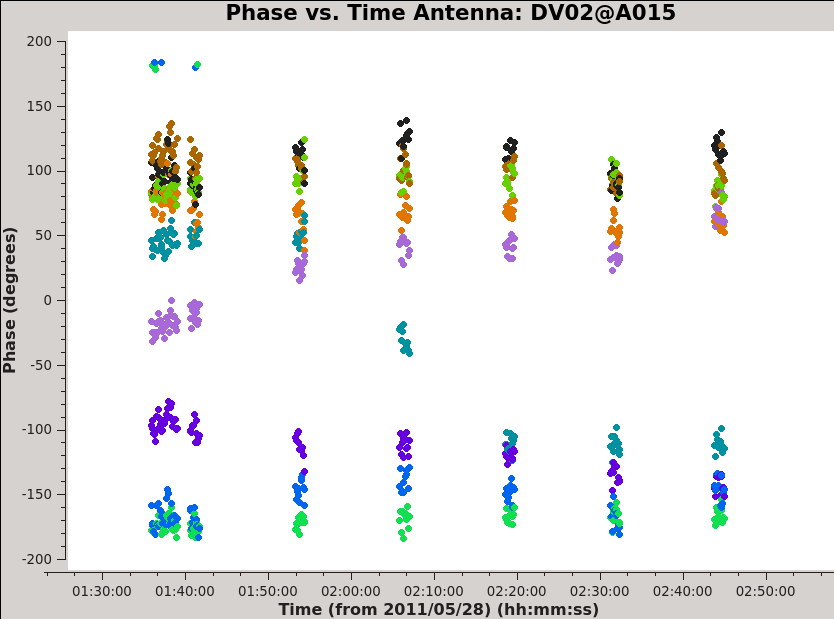
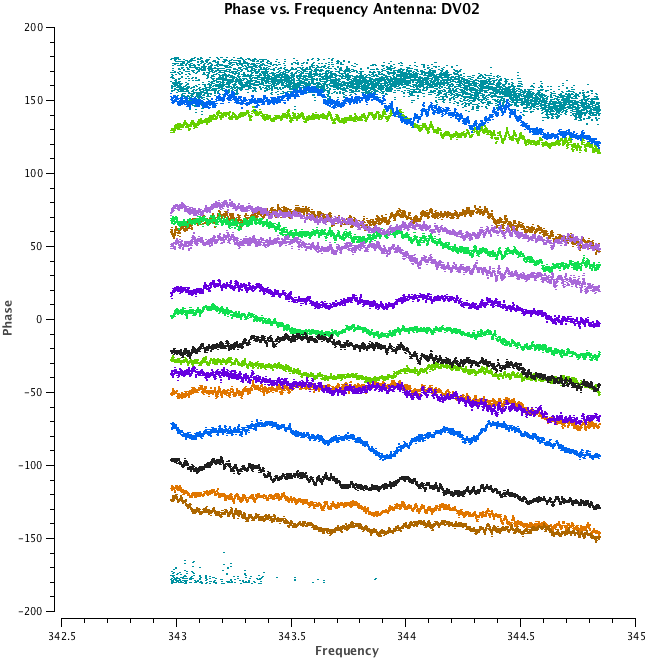
# In CASA
plotms(vis= asdm+'.split.ms',
xaxis='freq', yaxis='phase',
selectdata=True, field='3c279', corr='XX', antenna='*&*',
avgtime='1e8', avgscan=T,
coloraxis='baseline', iteraxis='antenna')
# In CASA
plotms(vis= asdm+'.split.ms',
xaxis='time', yaxis='phase',
selectdata=True, field='3c279',
spw='0:40~3800', antenna='*&*',corr='XX',
avgchannel='3840', avgscan=T,
coloraxis='baseline', iteraxis='antenna')
Figure 7 shows that the phase varies with time, thus it will need to be gain calibrated. In Figure 8 we see that phase variations as a function of frequency in dataset uid_A002_X1ff7b0_Xb are small, typically ~ 30 degrees, thus bandpass calibration will suffice (i.e. no delay calibration is needed).
We issue gaincal on 3c279 to determine phase(-only) gain solutions. We use solint='int' for the solution interval, which means that one gain solution will be determined for every integration time to prevent de-correlation of the signal. Once phase is corrected, we can determine the bandpass solutions with bandpass. We apply the phase calibration table on-the-fly with the parameter "gaintable". Bandpass response can vary from day to day, therefore we calculate independent bandpass solutions for each dataset.
#In CASA
for asdm in basename_all:
os.system('rm -rf '+asdm+'.bpphase.gcal,'+asdm+'.bandpass.bcal')
gaincal(vis = asdm+'.split.ms',
selectdata=T,field = '3c279',spw = '0:40~3800',
caltable = asdm+'.bpphase.gcal',
solint = 'int',refant = 'DV09',calmode='p')
bandpass(vis = asdm+'.split.ms',
field = '3c279',
gaintable = asdm+'.bpphase.gcal',
caltable = asdm+'.bandpass.bcal',
bandtype='B',
solint = 'inf',combine = 'scan', solnorm=T,refant = 'DV09',
minblperant=3,minsnr=2,fillgaps=1)
where:
- gaintable = asdm+'.bpphase.gcal', caltable = asdm+'.b1.cal': Gain calibration table, and bandpass calibration table
- solint='int' or 'inf': The former is to consider integration by integration. The latter, combined with the default combine='scan', sets the solution interval to the entire observation
- refant = 'DV09': Set the reference antenna to DV06
- calmode='p': Gain cal calibration only phase
- minblperant=3: Minimum number of baselines required per antenna for each solve
- minsnr=2: Minimum SNR for solutions
- bandtype='B': Channel by channel solution for each specified spw
- fillgaps=1: Interpolate channel gaps 1 channel wide
- solnorm=T: Normalize the bandpass amplitudes and phases of the corrections to unity
Do not worry about the message "Insufficient unflagged antennas" when running the bandpass task, which relates to the flagged edge channels.
We plot the time variation of the phase solutions (asdm+'.bpphase.gcal') using plotcal, to check that they vary smoothly with time.
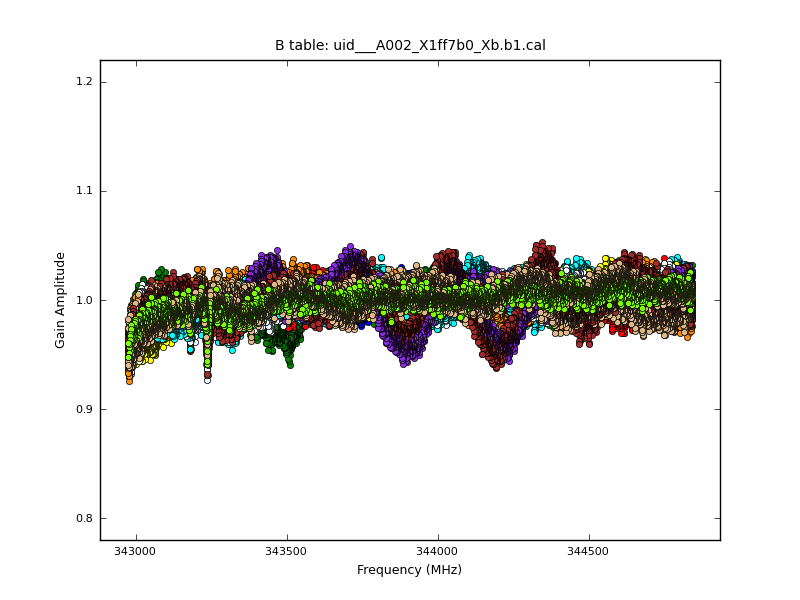
#In CASA
plotcal(caltable = asdm+'.bpphase.gcal',
xaxis = 'time',yaxis = 'phase',
iteration = 'antenna',plotrange=[0,0,-180,180])
We also plot the bandpass solutions with plotcal, and we see that the solutions seem reasonable, with amplitudes close to 1 (Figure 9), and phases that does not vary much over the spectral window.
#In CASA
plotcal(caltable = asdm+'.bandpass.bcal',
xaxis = 'freq',yaxis = 'amp',
plotrange = [0,0,0.8,1.2])
plotcal(caltable = asdm+'.bandpass.bcal',
xaxis = 'freq',yaxis = 'phase',
plotrange = [0,0,-100,100])
Flux Calibration
We set the flux for our flux calibrator, Titan, using the task setjy, by applying the Butler-JPL-Horizons 2010 model. First, we check the flux calibrator data. We plot the spectrum and find a bright CO emission (Figure 10).
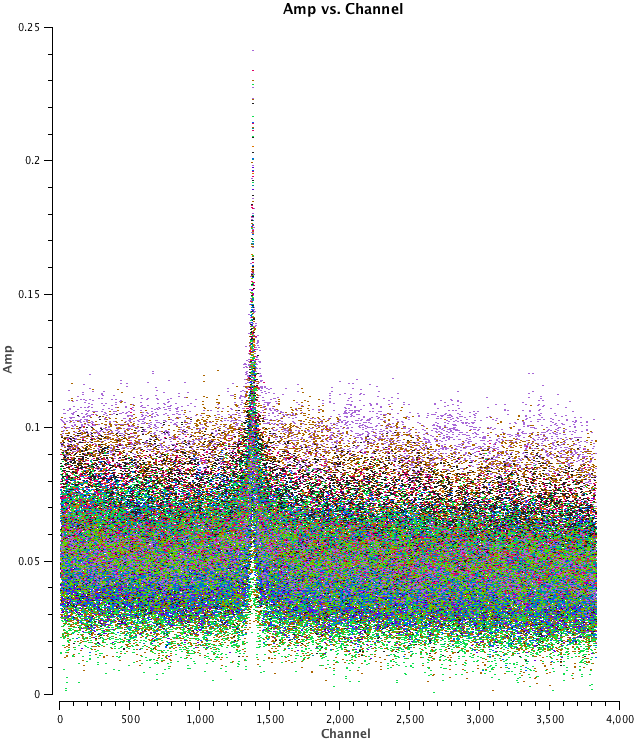
# in CASA
for asdm in basename_all:
flagdata(vis=asdm+'.split.ms',flagbackup=F,
field=['Titan'],
spw=['0:1100~1700'])
flagmanager(vis =asdm+'.split.ms',mode = 'save',versionname = 'FlagFlux')
Second, we do a new gain calibration applying the bandpass calibration solutions on-the-fly.
We solve for amplitude and phase simultaneously and determine average solutions per scan. Finally, we will bootstrap the flux density of the secondary calibrator from that of Titan using the task fluxscale.
# in CASA
for asdm in basename_all:
# os.system('rm -rf '+asdm+'.g2.cal,'+asdm+'.f1.cal')
os.system('rm -rf '+asdm+'.amp.gcal,'+asdm+'.flux.cal')
setjy(vis = asdm+'.split.ms',field = 'Titan',
standard = 'Butler-JPL-Horizons 2010')
gaincal(vis=asdm+'.split.ms',
gaintable=asdm+'.bandpass.bcal', caltable=asdm+'.intphase.gcal',
calmode='p',
field='Titan,3c279',
spw='0~1:40~3800',
refant='DV06', solint='int',minsnr=2.0,minblperant=4)
gaincal(vis=asdm+'.split.ms',
gaintable=asdm+'.bandpass.bcal', caltable=asdm+'.scanphase.gcal',
calmode='p',
field='Titan,3c279',
spw='0~1:40~3800',
refant='DV06', solint='inf',minsnr=2.0,minblperant=4)
gaincal(vis = asdm+'.split.ms',
# gaintable = asdm+'.b1.cal',caltable = asdm+'.g2.cal',
gaintable =[asdm+'.bandpass.bcal',asdm+'.intphase.gcal'],caltable = asdm+'.amp.cal',
calmode='ap'
field = 'Titan, 3c279',
refant = 'DV06',solint = 'int')
fluxscale(vis = asdm+'.split.ms',
# caltable = asdm+'.g2.cal',fluxtable = asdm+'.f1.cal',
caltable = asdm+'.amp.gcal',fluxtable = asdm+'.flux.cal',
reference = 'Titan',
transfer = '3c279')
The flux of Titan at these frequencies is about 2.9 Jy. For example, for dataset uid___A002_X1ff7b0_Xb.f1.cal:
#2011-07-13 07:31:04 INFO setjy Titan spwid= 0 [I=2.846, Q=0, U=0, V=0] Jy, (JPL-Butler Solar System Object)
The new flux table asdm+'.flux.gcal' replaces the previous asdm+'.amp.gcal table in future application of the calibration to the data, i.e. the new flux table contains both asdm+'.amp.gcal and the newly acquired flux scaling. Unlike the gain calibration steps, this is not an incremental table.
- gaintable = asdm+'.bandpass.bcal': We apply the bandpass calibration on-the-fly
- caltable = 'asdm+'.amp.cal: the output gain calibration table
- calmode = 'ap': To solve for amplitude and phase
We find that the flux of 3c279 is 10.45 Jy, by averaging the fluxes obtained from the ten available datasets. This flux agree within 10% with the most recent 0.850 mm measurements from the SMA calibrator list [1] : (01 Jul 2011, SMA 9.75 ± 0.49).
Applying the calibrations
Now we will use applycal to apply the bandpass and gaincal tables that we generated in the previous sections. First, we will apply the solutions to the bandpass and secondary calibrator (in this case, it is the same, 3c279). Second to the flux calibrator from the bandpass solutions and its own phase and flux solutions. Finally we will apply the bandpass and phase/amplitude solutions to the science target.
from the secondary calibrator to the science target and the secondary calibrator itself.
#In CASA
for asdm in basename_all:
applycal(vis=asdm+'.split.ms',field='3c279',
gaintable=[asdm+'bandpass.bcal',asdm+'.intphase.gcal',asdm+'.flux.cal'],
interp=['nearest','nearest','nearest'],
gainfield=['3c279','3c279','3c279'],flagbackup=T)
for asdm in basename_all:
applycal(vis=asdm+'.split.ms',field='Titan',
gaintable=[asdm+'bandpass.bcal',asdm+'.intphase.gcal',asdm+'.flux.cal'],
interp=['nearest','nearest','nearest'],
gainfield=['3c279','titan','titan'],flagbackup=T)
for asdm in basename_all:
applycal(vis=asdm+'.split.ms',field=['Ant*','NGC*']
interp=['nearest','linear','linear'],
gaintable=[asdm+'bandpass.bcal',asdm+'.scanphase.gcal',asdm+'.flux.cal'],
gainfield=['3c279','3c279','3c279'],flagbackup=T)
Checking the calibration
We plot the corrected amplitudes and phases of 3c279 as a function of time and frequency, to check that the phases are close to zero and the amplitudes are constant.
# In CASA
asdm=basename_all[0]
plotms(vis = asdm+'.split.ms', xaxis='time', yaxis='amp',
ydatacolumn='corrected', selectdata=True, field='3c279',
averagedata=True, avgchannel='3840', avgtime='',
avgscan=False, avgbaseline=F, coloraxis='spw')
plotms(vis = asdm+'.split.ms', xaxis='time', yaxis='pha',
ydatacolumn='corrected', selectdata=True, field='3c279',
averagedata=True, avgchannel='3840', avgtime='',
avgscan=False, avgbaseline=F, coloraxis='spw')
Next we can use plotms to examine the corrected amplitude and phase of Antennae as a function of frequency, just by changing the field to field='NGC*','Antennae*'.
Split source data and smoothing
We split the spectral window 0 for Antennae galaxies,where CO(3-2) line is. We separate between Northern and Southern mosaic datasets. We smooth the velocity to a width of 23 channels, corresponding to ~10 km/s.
basename_all_North=["uid___A002_X1ff7b0_Xb","uid___A002_X207fe4_X3a","uid___A002_X207fe4_X3b9","uid___A002_X2181fb_X49"]
for asdm in basename_all_North:
os.system('rm -rf Antennae-'+asdm+'.cal.ms')
split(vis = asdm+'.split.ms',outputvis = 'Antennae-'+asdm+'.cal.ms',
field = ['NGC*'],spw='0',width=23)
listobs(asdm+'.split.ms')
basename_all_South=["uid___A002_X1ff7b0_X1c8","uid___A002_X207fe4_X1f7","uid___A002_X207fe4_X4d7",
"uid___A002_X215db8_X18","uid___A002_X215db8_X1d5","uid___A002_X215db8_X392"]
for asdm in basename_all_South:
os.system('rm -rf Antennae-'+asdm+'.cal.ms')
split(vis = asdm+'.split.ms',outputvis = 'Antennae-'+asdm+'.cal.ms',
field = ['Antennae*'],spw='0',width=23)
listobs(asdm+'.split.ms')
Concatenating datasets for northern and southern mosaics
Once each individual dataset is calibrated, we finally concatenate the data sets corresponding to one either north and south mosaics into one big measurement set. We define an array "comvis" that contains the names of the measurement sets we wish to concatenate, and then we run the task concat.
# In CASA
comvis_South=[]
comvis_North=[]
for asdm in basename_all_South:
comvis_South.append('Antennae-'+asdm+'.cal.ms')
for asdm in basename_all_North:
comvis_North.append('Antennae-'+asdm+'.cal.ms')
os.system('rm -rf Antennae_South.cal.ms,Antennae_North.cal.ms')
concat(vis=comvis_South,concatvis='Antennae_South.cal.ms',timesort=T)
concat(vis=comvis_South,concatvis='Antennae_North.cal.ms',timesort=T)
Daniel Espada 12:00 UT, 21 July 2011